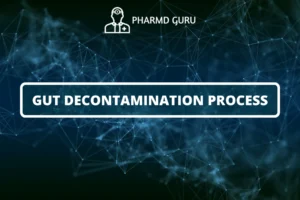Toxicokinetics refers to the study of the movement and transformation of toxic substances within the body. It focuses on understanding the processes of absorption, distribution, metabolism, and elimination of toxicants.
SCROLL DOWN TO THE BOTTOM OF THE PAGE FOR ACTUAL NOTES
TABLE OF CONTENTS:
- Introduction
- Pharmacokinetics: A Brief Overview
- Toxicokinetics: Understanding the Process
- 3.1. Absorption
- 3.2. Distribution
- 3.3. Metabolism
- 3.4. Elimination
- Factors Affecting Toxicokinetics
- Clinical Applications
Introduction
Toxicokinetics refers to the study of the movement and transformation of toxic substances within the body. It focuses on understanding the processes of absorption, distribution, metabolism, and elimination of toxicants. By gaining insights into toxicokinetics, healthcare professionals can better comprehend how toxic substances behave in the body and how they can be effectively managed in cases of poisoning or toxic exposures. This article provides an overview of toxicokinetics, its key components, and their significance in clinical practice.
Pharmacokinetics: A Brief Overview
Before delving into toxicokinetics, it is important to understand the concept of pharmacokinetics. Pharmacokinetics encompasses the study of the absorption, distribution, metabolism, and elimination of drugs or therapeutic substances within the body. It provides valuable insights into how drugs move through the body and are processed, ultimately influencing their therapeutic effects.
Toxicokinetics builds upon the principles of pharmacokinetics but focuses specifically on toxic substances, including environmental toxins, chemicals, drugs of abuse, and other harmful agents. The aim is to understand how these substances interact with the body and how their movement and transformation influence toxicity and potential adverse effects.
Toxicokinetics: Understanding the Process
Toxicokinetics involves four key processes that determine the fate and effects of toxic substances in the body:
3.1. Absorption
Absorption refers to the entry of toxic substances into the body. It primarily occurs through routes such as ingestion (via the gastrointestinal tract), inhalation (via the respiratory system), dermal contact (through the skin), or injection (directly into the bloodstream). The rate and extent of absorption depend on factors such as the route of exposure, physicochemical properties of the toxicant, and the characteristics of the exposed tissue or organ.
3.2. Distribution
Once absorbed, toxic substances distribute throughout the body via the bloodstream. Distribution is influenced by various factors, including blood flow to different tissues and organs, the solubility of the toxicant in various body compartments, and the presence of binding proteins. Some substances may have a preference for specific organs or tissues based on their physicochemical properties.
3.3. Metabolism
Metabolism involves the transformation of toxic substances into different compounds through chemical reactions in the body. The primary site of metabolism is the liver, although other organs such as the lungs, kidneys, and intestines can also play a role. Metabolic processes can either activate or deactivate toxic substances, leading to changes in their toxicity and potential effects on the body. Enzymes, particularly those belonging to the cytochrome P450 family, play a crucial role in drug and toxicant metabolism.
3.4. Elimination
Elimination refers to the removal of toxic substances from the body. It primarily occurs through processes such as renal excretion (via the kidneys), biliary excretion (via the bile into the gastrointestinal tract), or exhalation (via the lungs). The rate of elimination determines the duration of exposure to the toxic substance and influences its potential toxicity. The kidneys and liver are key organs involved in the elimination of toxicants.
Factors Affecting Toxicokinetics
Several factors can influence the toxicokinetics of a substance, including:
- Dose: The amount of toxic substance administered or encountered.
- Route of Exposure: The pathway through which the substance enters the body.
- Physicochemical Properties: The chemical characteristics of the toxicant, such as its molecular weight, solubility, lipophilicity, and stability.
- Individual Variability: Factors specific to the individual, including age, sex, genetics, underlying health conditions, and concurrent medications or substances.
- Metabolic Interactions: Interactions between the toxic substance and endogenous or exogenous compounds that can influence its metabolism and elimination.
- Organ Function: The functioning of organs involved in toxicant metabolism and elimination, particularly the liver and kidneys.
Understanding these factors is crucial in assessing the potential toxicity of a substance and determining the most appropriate management strategies in cases of poisoning or toxic exposures.
Clinical Applications
Knowledge of toxicokinetics has several clinical applications, including:
- Toxicity Assessment: Understanding the toxicokinetic properties of a substance helps predict its potential toxicity and adverse effects.
- Treatment Planning: Knowledge of toxicokinetics aids in developing appropriate treatment strategies, such as enhancing elimination, administering antidotes, or providing supportive care.
- Dose Adjustment: Understanding the toxicokinetics of a substance helps in determining appropriate dosing regimens, especially in cases where altered elimination or metabolism may affect drug levels.
- Toxicological Monitoring: Monitoring toxicokinetic parameters can guide the assessment of toxicant exposure, the effectiveness of treatment, and the evaluation of potential long-term effects.
ACTUAL NOTES




